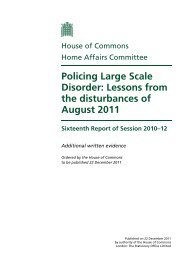A gap or a chasm? - National Police Library Online Catalogue
A gap or a chasm? - National Police Library Online Catalogue
A gap or a chasm? - National Police Library Online Catalogue
Create successful ePaper yourself
Turn your PDF publications into a flip-book with our unique Google optimized e-Paper software.
A <strong>gap</strong> <strong>or</strong> a <strong>chasm</strong>? Attrition in rep<strong>or</strong>ted rape cases<br />
x<br />
● Whilst this represents the largest data-set in the UK literature on rape and sexual<br />
assault, there are some limitations to the study. It proved extremely difficult to<br />
recruit research participants in the Comparison areas, so m<strong>or</strong>e is known about<br />
complainants in areas where there is a SARC. Obtaining inf<strong>or</strong>mation on case<br />
outcomes was also problematic in all areas, and there is only final outcome data<br />
f<strong>or</strong> two-thirds of the sample.<br />
What we know about rape and attrition<br />
● Findings from the 2001 British Crime Survey (BCS) interpersonal violence module<br />
result in a prevalence rate of 0.3 per cent f<strong>or</strong> rape of women over 16 in the year<br />
pri<strong>or</strong> to interviews conducted in 2001, and this equates to an estimated annual<br />
incidence rate of 47,000 adult female victims of rape. Since the age of 16, 7 per<br />
cent of women had suffered a serious sexual assault at least once in their lifetime<br />
(5% had been raped). The same study confirms that women are most likely to be<br />
raped by men they know, and a considerable pro p o rtion re p o rted re p e a t<br />
incidents by the same perpetrat<strong>or</strong>.<br />
● These findings are lower than a previous BCS-based rep<strong>or</strong>t, and much lower than<br />
the prevalence rate in a dedicated study on rape from the early 1990s.<br />
● Analysis of the St Mary ’s database (covering the years 1987-2002) re v e a l e d<br />
i n c reasing numbers of young victims aged under 20, and supp<strong>or</strong>ts the BCS<br />
finding that assaults are most likely to be committed by known men.<br />
● Home Office data on re p o rted rape cases in England and Wales show a continuing<br />
and unbroken increase in re p o rting to the police over the past two decades, but a<br />
relatively static number of convictions, thus the increasing justice <strong>gap</strong>.<br />
● Prosecuted cases involving children were m<strong>or</strong>e likely to result in conviction than<br />
those involving adults.<br />
● All UK studies of attrition in rape cases concur that the highest prop<strong>or</strong>tion of cases<br />
is lost at the earliest stages, with between half and two-thirds dropping out at the<br />
investigative stage, and withdrawal by complainants one of the most imp<strong>or</strong>tant<br />
elements.<br />
● A number of studies have found high rates of ‘no criming’, not limited to the<br />
official guidelines f<strong>or</strong> this categ<strong>or</strong>y.<br />
● R e s e a rch to date has identified four key points at which attrition occurs: the<br />
decision to rep<strong>or</strong>t; the investigative stage; discontinuance by prosecut<strong>or</strong>s; and the<br />
trial. Victim withdrawals can occur at each stage but the highest pro p o rtion is<br />
evident at the first two points.

















